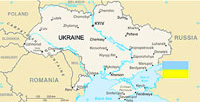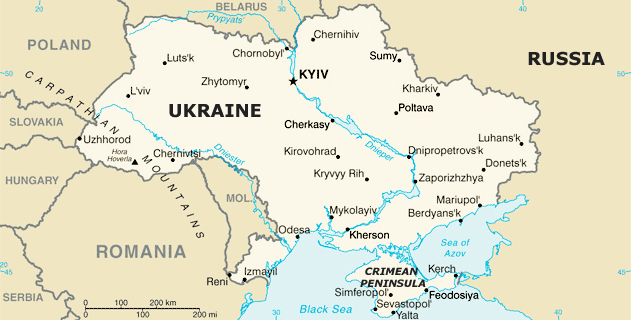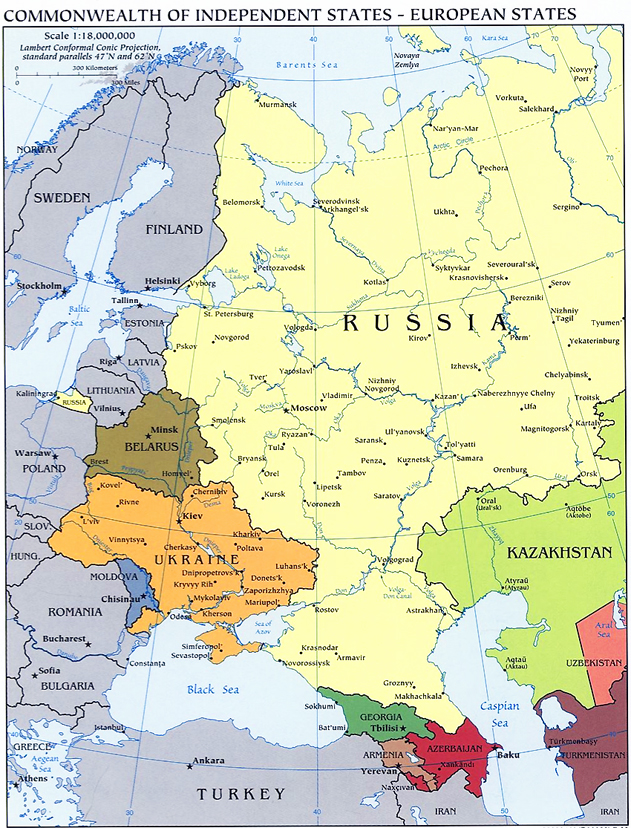PONARS Perspectives: U.S. Military Assistance to Ukraine

(PONARS Eurasia – ponarseurasia.org – February 5, 2015)
PONARS Eurasia is a network of over 100 academics, mainly from North America and post-Soviet Eurasia, who advance new policy approaches to research and security in Russia and Eurasia.
Eight former senior military and diplomatic officials have called for the United States to provide $1 billion a year in military assistance to Ukraine over the next three years (see their report here http://www.thechicagocouncil.org/ukraine). This would be primarily for non-lethal items but also allow for the provision of weaponry such as light anti-armor missiles. Should Washington take their advice?
Volodymyr Dubovyk, Mechnikov National University (Odessa):
I believe that Washington should take their advice. So far, Moscow has sensed weakness in the West’s position. Sanctions are working, perhaps, but not biting enough or quickly enough, so something else is needed to try and alter the Russian onslaught on Ukraine. Receiving some of these weapons would surely increase the cost of further Russian intervention in Ukraine. This is not about Ukraine winning a war against Russia but about preventing Ukraine losing its agency and integrity, and salvaging Ukraine’s independence. So far, the road toward escalation was via talks and statements. That is exactly what Moscow expects from the West. The time has come for a new set of actions.
Sergiy Kudelia, Baylor University (Texas):
The provision of limited defensive weaponry to Ukraine should be strictly conditional on the agreement of Ukrainian authorities to launch official talks with the insurgents on settling the conflict. It should also be done only in conjunction with the creation of a humanitarian fund to provide medical and food supplies to civilians in the Donbas. By itself, “lethal aid” from the United States is only likely to prolong the conflict, increase the intensity of fighting, and reinforce the anti-American narrative presenting the war as the result of U.S. scheming. Any new ceasefire deal will not hold as long as there are no follow-up negotiations with the insurgent forces on a comprehensive peace agreement. If the goal of the U.S. government is to achieve a lasting peace in eastern Ukraine, it should use its leverage to compel the Ukrainian government to agree to the partitioning of the Donbas. The United States should also use its diplomatic experience from resolving secessionist conflicts to advise the Ukrainian side on the proper institutional terms of the settlement. Finally, the United States should begin a diplomatic dialogue with Russia to facilitate multilateral negotiations regarding the final status of breakaway territories in the Donbas with the promise of lifting sanctions once the implementation of the final agreement begins.
Kimberly Marten, Barnard College and Harriman Institute, Columbia University (New York):
The United States should not send weapons to Ukraine. First, Ukraine does not have a reliable and professional military, and this means the United States will have no control over how the weapons are used on the ground. They could be used to target opposing civilians by hyper-nationalist militias; they could even be used against targets in Russia by those who want to provoke a wider war. Second, the plan is based on the assumption that more weapons will deter Putin from taking further action or cause him to back down. But everything we know about Putin’s personality says that when he is threatened he will fight harder. Furthermore, he cannot be seen as backing down in the face of a Western threat and still maintain the image he has carefully cultivated as a strongman. He has been preparing the ground for the possibility of open Russian military involvement in Ukraine by saying that the conflict is really NATO’s attempt to threaten Russian sovereignty and security. He is most likely to ramp up the conflict, not tamp it down, if the United States sends weapons to Ukraine.
Sergey Minasyan, Caucasus Institute (Yerevan):
Of course appeasement is not an option in such a conflict. However, the main problem is that there is no guarantee there will be any further U.S. response if Russia escalates militarily, possibly even before Javelin anti-tank missiles or other American weaponry were to reach Ukraine. That is why such a step may only increase the consequences and pain of war for Ukrainians.
A strong signal from the U.S. government is not enough if there is no determination for a subsequent military step. A completely different situation exists now than, say, during the Russian-Georgian war of August 2008. Russia is more motivated and the stakes are higher; it will not be deterred only by strong signals from Washington.
If the U.S. demonstrated a clear determination to escalate military support beyond a decision to provide arms to Ukraine, that would be another matter (leaving aside the risk of direct U.S.-Russian conflict and taking into account the nuclear factor). But in its absence? The Kremlin will have the advantage, even if just a propagandistic one, of escalating in Ukraine without facing real consequences from the West.
There is already no good option for assisting Ukraine through the provision of arms. At the current stage, any direct military-technical assistance will increase the escalation spiral without actually helping the country.
Oxana Shevel, Tufts University (Boston):
Washington should seriously contemplate military assistance as part of a broader strategy for ending the conflict in Ukraine. It should not treat the option in a black-white/yes-no manner; it should take some but not all of the advice in the report. The main argument against military assistance to Ukraine is that it is more likely to encourage than discourage Russia from escalating the conflict, which would increase death and destruction, especially among civilians. These concerns are valid, but they could be mitigated by providing only the kind of equipment that would bolster Ukraine’s defenses and enable it to halt the further military advances of the Russia-backed separatists.
Since the September 2014 Minsk Agreement, with generous supplies of arms, advisers, and manpower from Russia, the separatists have gradually captured about 200 square miles of territory beyond the separation line agreed to in Minsk. In recent weeks, they have abandoned the agreement altogether, escalating the situation to an all-out offensive. Further, they have openly declared their intention to capture at least all of the Donetsk and Luhansk regions. The separatist offensive has been slow and bloody. It is clear that the Ukrainian army, weak as it may be, is going to fight tooth and nail for every town it holds. If the separatist offensive continues, the humanitarian tragedies in towns like Vuhlehirsk and Debaltseve will be replayed across the region. A way to stop this misery from spreading is to secure a “hold” at the current line of contact. Limited Western military assistance may help the Ukrainian army do just that.
Non-lethal items such as communication equipment, reconnaissance drones, armored transport vehicles, and medical equipment may substantially bolster Ukrainian defense capabilities and help them hold the line. The West can stop short of supplying lethal items.
Escalation has costs for Russia. Russia has been eager to maintain its narrative of not being a party to the conflict. Escalation would have to involve the shipment of Russian troops and weapons that may be impossible to conceal from domestic and western audiences. Without the veneer of plausible deniability, Russia will be looking at stiffer sanctions and removal from the SWIFT system, which could deal a deathblow to the Russian economy.
Ultimately, the decision on military assistance to Ukraine should be taken as part of a broader Western strategy. This requires being honest about which Russian concerns the West is willing to address and which red lines it will not allow to be crossed.
If the West’s decision on limited military aid to Ukraine came with a peace plan to Russia and Ukraine over the Donbas – possibly a plan that is more advantageous to the separatist areas than the Minsk agreement – it may avoid escalation, and, at a minimum, prevent further civilian deaths.
Nikolai Sokov, Vienna Center for Disarmament and Non-Proliferation (Vienna):
My reading of Moscow’s intentions lately has been that it wanted to deescalate without losing face. This was difficult – if not impossible – given the international situation and low control of DNR/LNR. This option is now closed. The problem is Putin will find it easier to escalate than Washington, so there will be more difficult choices for the latter in the near future.
Although provision of Soviet weaponry is the most logical way to go, there are two interesting aspects that the report did not touch. First, these weapons will likely be replaced, meaning that East/Central European NATO members would get modern Western weapons instead. This is very compatible with recent pronouncements by the administration and perhaps one of the reasons why the proposal about military assistance was accepted.
Second, the effectiveness of that assistance will primarily depend on Kyiv’s ability to use it. Unfortunately, the government is pretty dysfunctional, both in the way it fights the war and especially in the way it conducts economic and political reforms. In fact, it seems to me that war has been primarily used to fight for influence inside Kyiv instead of for any other purposes. Moreover, I am shocked at how the strongest tool of consolidating the country around the government and pushing through necessary reforms – the external threat – has been largely wasted. The apparent failure of the ongoing mobilization indicates that the public is not supportive – perhaps not of war, but of the government definitely. Arms cannot win a war – it takes an army, high command, and government to do that.
The domestic politics part has been missing from the earlier debate, but in my mind this is the most important piece of the picture. One could expect confusion and inefficiency in the first few months, but not that late into the war.
Stanislav Tkachenko, St. Petersburg State University (St. Petersburg):
Washington should not take the advice to provide military assistance. It will never be implemented in its original form. If a “yes” decision is made, Russia will immediately respond to it by providing even more weapons and “volunteers” to the separatists in the Donbas. The whole of the Donetsk and Luhansk regions could very well be under the control of the separatists even before the first delivery of U.S. armaments. A “yes” decision by the U.S. will open a new stage in Ukraine’s civil war, effectively transforming it into a proxy war between the United States and Russia. It will move the whole world one-step closer to nuclear war between Washington and Moscow. It is obvious that key European allies are opposed to the decision. It will be a huge mistake for the White House to accept advice that has negative short- and long-term consequences!
Cory Welt, George Washington University (Washington, DC):
A decision to supply military assistance to Ukraine – and what kind – will ultimately be a political one. Whatever the decision, it should not be defended on the basis that the assistance will enable Ukraine to hold its current line of defense and persuade Russia to refrain from further escalation. We simply do not know how Russia will respond, although I suspect an initial escalation is more likely than not. Before providing even non-lethal military equipment, therefore, the U.S. ought to have a plan in place for how it will respond to another round of escalation – and a plan that does not involve a constant ratcheting up of military assistance. The U.S. should also be prepared for the contingency by which Ukraine remains outgunned despite an influx of military assistance and is forced to negotiate a peace on less favorable terms than those that hold now. Without such planning, it may be preferable to first strive to maintain the current line of defense through other means than military assistance.


